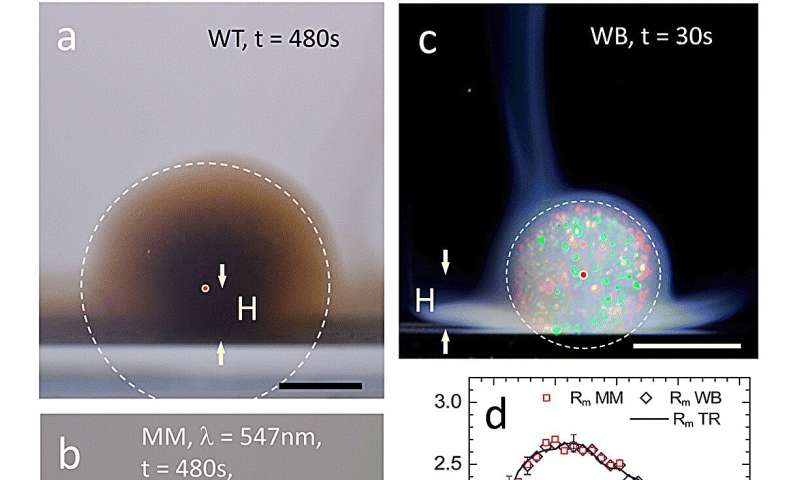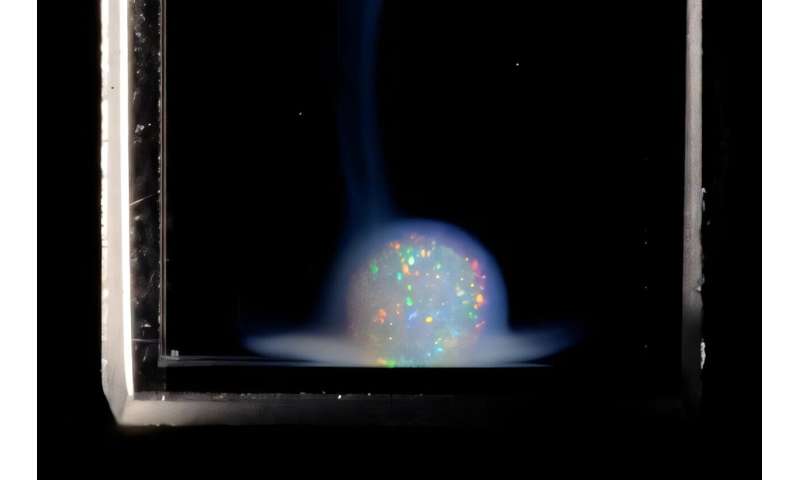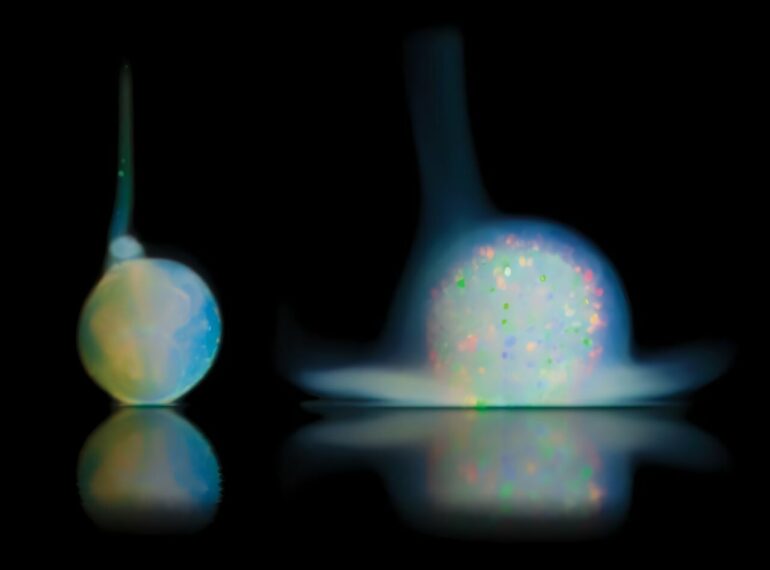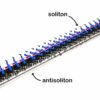When driving though a bank of fog, car headlights are only of limited help as the light is scattered by the water particles suspended in the air. The situation is similar when you try to observe the inside of a drop of milk in water or the internal structure of an opal gem with the help of white light. In all these cases, multiple light scattering effects prevent examination of the interior.
A team of researchers at Johannes Gutenberg University Mainz (JGU) and Heinrich Heine University Düsseldorf (HHU) has now surmounted this difficulty and demonstrated a new method to study the interior of a crystalline drop. Their findings have been published recently in the journal Soft Matter.
Monochromatic illumination sheds light on the problem
When you put a drop of ink into water, we all know the result: the ink particles will gradually disperse by simple diffusion. It is not necessarily the same, however, when a drop consisting of particles that strongly repel each other is considered.
A few simulations exist for some rather exotic materials such as dusty plasma, which—like the matter that makes up the sun—consists of repulsive particles. Predictions for drops made of repelling particles suspended in a liquid have been missing. Also experimentally, all attempts to measure the three-dimensional behavior of such a drop have proved futile.
However, researchers have now developed a method using very simple lab tools that can be used for investigation in cases where white light cannot penetrate and the use of X-ray would be not expedient. Their approach exploits the fact that the color of multiple scattered light depends on the local concentration of particles. This effect is even enhanced when the material is crystalline. Thus, regions of different particle concentration will appear in different colors.
In principle, concentrated regions shimmer in bright blue, others, where the particles are further apart, exhibit a reddish hue. Illuminating the drop with white light, which is a mixture of different wavelengths, all colors are scattered simultaneously and it is practically impossible to determine the exact origin of each color within the overall turbid and whitish drop.
“We overcame this difficulty by consecutively illuminating the drops with different monochromatic light, i.e., light of individual wavelengths,” explained Professor Palberg from JGU. For each wavelength, multiple scattering only occurred in regions of suitable particle concentration, while the rest of the drop became transparent for this wavelength.
“Thus, we are able to see where exactly the red or blue light was scattered from deep inside the drop. Using our technique, we now can—with a high degree of spatial and temporal resolution—examine the density profile of crystalline, turbid drops and even that of other cloudy media.”
For instance, this method could be useful to analyze the concentration gradients of sedimenting slurries or determine the degree of homogenization obtained when stirring paint diluted with solvent.

Examples of processed images from different illumination/observation modes and their evaluation. © Soft Matter (2024). DOI: 10.1039/D4SM00413B

An opalescent drop, several millimeters in diameter, under white light illumination. While there are a few individual reflections visible at the drop rim, the drop interior cannot be observed. © Soft Matter (2024). DOI: 10.1039/D4SM00413B
Complex expansion profile of crystalline drops
In their recent paper, the researchers applied their new method to study drops of a suspension composed of equally charged and hence repelling small polymer spheres suspended in water. Initially, these particles are interacting so strongly that the undiluted suspension forms a polycrystalline material. Such a suspension is very similar in appearance to a gem opal and shows very strong multiple scattering. However, as soon as a drop of it is placed in water, it starts expanding.
“With this pioneering work, we were able to establish that the expansion profile of this crystalline material is relatively complex. There is neither a constant overall density with a precisely defined outer edge nor is there a straightforward diffusion profile as one might expect from a drop of non-repelling particles in a liquid medium,” said Palberg.
In addition, there is initial rapid expansion of the crystalline sphere due to the mutual repulsion between the particles before the crystals disintegrate at the drop rim due to their dilution, and the drop gradually begins to shrink.
While the lab experiments were being performed at Mainz University, the team of Professor Hartmut Löwen at HHU was undertaking theoretical modeling of the density profile based on dynamical density functional theory.
“There was promising correlation between the results of experimentation and modeling, indicating the good predictive power of this kind of theory,” stated Löwen.
In fact, the calculated density profile also showed a central maximum density and a radial density gradient which flattened with time. Remarkably, even the time of maximum expansion of the crystalline drop was predicted accurately. It can be concluded that the size of a drop is determined by two opposed processes: it expands continuously while, simultaneously, it melts at its contour.
“The interplay between these two processes yields an expansion scenario which differs in qualitative terms from what has been predicted from the modeling of plasmas,” concluded the researchers. They now plan to continue with their investigations by systematically varying the level of repulsion of the particles to find out how this influences density profile and expansion dynamics.
More information:
Marcus U. Witt et al, Accessing the free expansion of a crystalline colloidal drop by optical experiments, Soft Matter (2024). DOI: 10.1039/D4SM00413B
Provided by
Johannes Gutenberg University Mainz
Citation:
A look into cloudy liquids: New method makes the expansion of turbid drops in water visible (2024, October 17)



